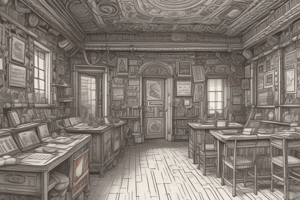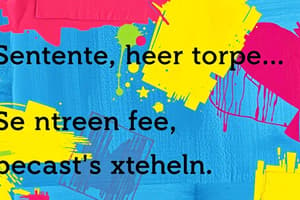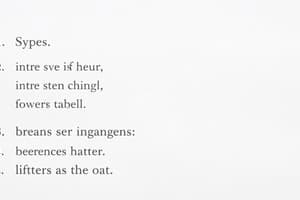Podcast
Questions and Answers
Which of the following is an example of personification?
Which of the following is an example of personification?
- He is as brave as a lion.
- The sun smiled down on us. (correct)
- She ran quickly.
- The book is on the table.
A simile uses the words 'like' or 'as' to make a comparison.
A simile uses the words 'like' or 'as' to make a comparison.
True (A)
Define ethos in persuasive writing.
Define ethos in persuasive writing.
Ethos is a form of persuasive writing that focuses on ethics, establishing personal credibility to gain the audience's trust.
A _________ sentence consists of two or more independent clauses joined by a coordinating conjunction.
A _________ sentence consists of two or more independent clauses joined by a coordinating conjunction.
Match the literary element with its correct definition:
Match the literary element with its correct definition:
Which of the following is NOT a type of figurative language?
Which of the following is NOT a type of figurative language?
Alliteration is defined as a comparison using 'like' or 'as.'
Alliteration is defined as a comparison using 'like' or 'as.'
What is pathos in writing?
What is pathos in writing?
What is the definition of zeugma?
What is the definition of zeugma?
The word 'visitor' has a more positive connotation than the word 'guest'.
The word 'visitor' has a more positive connotation than the word 'guest'.
What is the primary function of a preposition?
What is the primary function of a preposition?
A sentence that makes a request or gives a command is called an __________.
A sentence that makes a request or gives a command is called an __________.
Match the following terms with their definitions:
Match the following terms with their definitions:
What type of sentence is 'What time is it?'
What type of sentence is 'What time is it?'
A gerund is a verb that functions as a noun and ends in -ing.
A gerund is a verb that functions as a noun and ends in -ing.
What is tone in literature?
What is tone in literature?
An idea or theory expressed as a statement is known as a __________.
An idea or theory expressed as a statement is known as a __________.
Which of the following is an example of a complex sentence?
Which of the following is an example of a complex sentence?
Asyndeton is used to emphasize a list by including conjunctions.
Asyndeton is used to emphasize a list by including conjunctions.
What does 'mood' refer to in literature?
What does 'mood' refer to in literature?
The use of repeated conjunctions to create emphasis is called __________.
The use of repeated conjunctions to create emphasis is called __________.
Match the following sentence types with their definitions:
Match the following sentence types with their definitions:
What is diction?
What is diction?
Antithesis combines two similar ideas in a sentence.
Antithesis combines two similar ideas in a sentence.
What is the function of imagery in writing?
What is the function of imagery in writing?
An example of ___ is using the word 'crown' to refer to a king.
An example of ___ is using the word 'crown' to refer to a king.
Match the literary devices with their definitions:
Match the literary devices with their definitions:
Which of the following is a characteristic of parallelism?
Which of the following is a characteristic of parallelism?
A cumulative sentence begins with the main clause followed by modifiers.
A cumulative sentence begins with the main clause followed by modifiers.
Define 'motif' in literature.
Define 'motif' in literature.
The phrase 'Life is like a box of chocolates' is an example of an ___.
The phrase 'Life is like a box of chocolates' is an example of an ___.
Match the following examples with their corresponding literary devices:
Match the following examples with their corresponding literary devices:
What is the primary purpose of repetition in literature?
What is the primary purpose of repetition in literature?
An exclamatory sentence expresses a weak emotion.
An exclamatory sentence expresses a weak emotion.
Describe what 'context' means in literature.
Describe what 'context' means in literature.
A series of three related phrases or clauses is called a ___.
A series of three related phrases or clauses is called a ___.
What does 'exigence' refer to in writing?
What does 'exigence' refer to in writing?
Flashcards
Simple Sentence
Simple Sentence
A single independent clause.
Phrase
Phrase
A group of words that function as a single part of speech, but do not have a subject or a verb.
Alliteration
Alliteration
The repetition of the same letter or sounds at the beginning of words next to or close to each other.
Simile
Simile
Signup and view all the flashcards
Personification
Personification
Signup and view all the flashcards
Noun
Noun
Signup and view all the flashcards
Compound Sentence
Compound Sentence
Signup and view all the flashcards
Denotation
Denotation
Signup and view all the flashcards
Diction
Diction
Signup and view all the flashcards
Imagery
Imagery
Signup and view all the flashcards
Repetition
Repetition
Signup and view all the flashcards
Litotes
Litotes
Signup and view all the flashcards
Antithesis
Antithesis
Signup and view all the flashcards
Ellipsis
Ellipsis
Signup and view all the flashcards
Assonance
Assonance
Signup and view all the flashcards
Parallelism
Parallelism
Signup and view all the flashcards
Symbol
Symbol
Signup and view all the flashcards
Writer
Writer
Signup and view all the flashcards
Message
Message
Signup and view all the flashcards
Motif
Motif
Signup and view all the flashcards
Juxtaposition
Juxtaposition
Signup and view all the flashcards
Metonymy
Metonymy
Signup and view all the flashcards
Appositive
Appositive
Signup and view all the flashcards
Zeugma
Zeugma
Signup and view all the flashcards
Adverb
Adverb
Signup and view all the flashcards
Polysyndeton
Polysyndeton
Signup and view all the flashcards
Irony
Irony
Signup and view all the flashcards
Anthimeria
Anthimeria
Signup and view all the flashcards
Hyperbole
Hyperbole
Signup and view all the flashcards
Imperative Sentence
Imperative Sentence
Signup and view all the flashcards
Genre
Genre
Signup and view all the flashcards
Clause
Clause
Signup and view all the flashcards
Paradox
Paradox
Signup and view all the flashcards
Anaphora
Anaphora
Signup and view all the flashcards
Logos
Logos
Signup and view all the flashcards
Declarative Sentence
Declarative Sentence
Signup and view all the flashcards
Audience
Audience
Signup and view all the flashcards
Metaphor
Metaphor
Signup and view all the flashcards
Subordinating Conjunction
Subordinating Conjunction
Signup and view all the flashcards
Coordinating Conjunction
Coordinating Conjunction
Signup and view all the flashcards
Asyndeton
Asyndeton
Signup and view all the flashcards
Gerund
Gerund
Signup and view all the flashcards
Interrogative Sentence
Interrogative Sentence
Signup and view all the flashcards
Infinitive
Infinitive
Signup and view all the flashcards
Thesis
Thesis
Signup and view all the flashcards
Study Notes
Sentence Types
- Simple Sentence: A single independent clause. Example: Music from the 80s rocks.
- Compound Sentence: Two or more independent clauses joined by a coordinating conjunction. Example: That house is too expensive, and that house is too small.
- Complex Sentence: At least one independent clause and one dependent clause joined together by a subordinating conjunction. Examples: You cannot leave the school until the bell rings; Before I go to bed, I like to read a book.
- Declarative Sentence: States a fact or makes a statement. Example: The cat is sleeping on the sofa.
- Interrogative Sentence: Asks a question. Example: What is your name?
- Imperative Sentence: Makes a request or gives a command. Example: Clean up your mess.
- Exclamatory Sentence: Expresses strong emotions. Example: What a large dog!
- Fragment: An incomplete sentence, lacking a subject, verb, or both. (No example provided in the original text)
- Periodic Sentence: Complex sentence with the main clause at the end. Example: Despite the pouring rain, the strong winds, and the treacherous path, the hikers finally reached the summit.
Rhetorical Devices & Figures of Speech
- Simile: A comparison using "like" or "as." Example: The sleeping baby looks like an angel.
- Metaphor: Comparing unlike things directly. Example: "Couch potato," "night owl," "heart of gold."
- Personification: Giving human qualities to non-human things. Example: The trees whispered softly.
- Hyperbole: Exaggerated statement. Example: "That car ride took 14 million years."
- Irony: Expression with a meaning opposite to the literal. Example: The Titanic, built to be ’unsinkable’ is now a wreck at the bottom of the sea.
- Litotes: Ironic understatement. Example: You won’t be sorry (meaning you’ll be glad).
- Antithesis: Contrasting ideas in parallel structure. Example: "We must learn to live together as brothers or perish together as fools."
- Paradox: Self-contradictory statement. Example: The beginning of the end.
- Allusion: Implied or indirect reference, often to literature. Example: Achilles Heel.
- Alliteration: Repetition of consonant sounds at the beginning of words. Example: Looks like lions love licking lizards.
- Assonance: Repetition of vowel sounds in non-rhyming words. Example: The light of fire is a sight to admire.
- Anaphora: Repetition of words or phrases at the beginning of successive clauses. Example: You’re damned if you do, and you’re damned if you don’t.
- Anadiplosis: Repetition of the last word of a preceding clause. Example: "Tonight, we are a country awakened to danger and called to defend freedom. Our grief has turned to anger, and anger to resolution."
- Epistrophe: Repetition of a word or phrase at the end of successive clauses. Example: "Government of the people, by the people, for the people, shall not perish from the earth."
- Polysyndeton: Deliberate use of conjunctions between words or clauses. Example: "If there be cords, or knives, or poison, or fire, or suffocating streams, I'll not endure it."
- Asyndeton: Omitting conjunctions between words or clauses. Example: Live, laugh, love.
- ** Zeugma:** Use of a single word to modify or govern two or more words in different senses. Example: She opened the door and her heart to the stray kitten.
- Anthimeria: Using a word as a different part of speech. Example: "Chill" (originally a noun, meaning "cold") being used as a verb.
- Parallelism: Similarity of structure in related words, phrases, or clauses. Example: For the support of this declaration, with a firm reliance on the protection, we mutually pledge to each other our Lives, our Fortunes, and Sacred Honor.
- Juxtaposition: Placing two opposing elements side-by-side. Example: All is fair in love and war.
- Metonymy: Substituting a word for another closely associated word. Example: "Crown" to mean "king."
- Appositive: Noun or pronoun placed beside another to identify or describe it. Example: Mr. Jones, the French teacher, is married to the volleyball coach.
- Tricolon: A rhetorical device using three parallel phrases, clauses, or sentences. Example: I came, I saw, I conquered.
- Isocolon: Similar structure and length in parallel phrases. Example: Buy one, get one free.
Other Grammatical and Literary Concepts
-
Phrase: A group of words functioning as a single part of speech, without a subject or verb. Example: The girl, wearing a pink sweater, was very pretty.
-
Clause: A group of words containing a subject and verb. Example: I did not bring my umbrella.
-
Noun: Words describing a person, place, thing, or idea. Example: Dog, school, anger.
-
Verb: An action word. (No examples provided in the text.)
-
Adjective: Modifies a noun or pronoun. Example: The large dog
-
Adverb: Modifies a verb, adjective, or clause. Example: Works hard, Runs slowly.
-
Preposition: Shows relationship between a noun or pronoun and another word. Examples: above, at, after, about, with, across.
-
Connotation: The associated meaning or feeling of a word. Example: Visitor vs. guest
-
Denotation: Literal meaning of a word (dictionary definition). Example: The word “denotation”'s meaning when used in the example in the text.
-
Gerund: A verb ending in -ing used as a noun. Example: Bicycling is perfect.
-
Infinitive: Verb form starting with "to" used as a noun, adjective, or adverb. Example: I am going to write a story.
-
Participle: Verb form used as an adjective. Example: Growing teenagers need nutritious diets.
-
Absolute: Consists of a participle, noun, and modifiers, functioning as an adverb. Example: The dog waiting inside all day, we rushed to let him out.
-
Thesis: A statement or idea backed by arguments. Example: Climate change endangers life on Earth.
-
Tone: Author's attitude towards the audience. Example: optimistic tone.
-
Mood: Feeling evoked in the reader. Example: A dark and stormy night.
-
Diction: Word choice. Examples: Formal: "The analysis provided compelling evidence." Informal: "I was like, totally freaking out"
-
Imagery: Evoking senses through description. Example: The gigantic mountains had a beautiful sunset behind them.
-
Genre: Category of writing. Example: Science Fiction, Fantasy.
-
Purpose: The author's reason for writing. Example: To educate, inform, entertain.
-
Audience: Readers the work is intended for.
-
Subject: The central topic or issue.
-
Message: Main idea or theme, often including moral lessons.
-
Motif: Recurring subject, theme, or idea.
-
Analogy: Comparison for explanation. Example: Life is like a box of chocolates.
-
Anecdote: Short story about a real incident or person. Example: Locking myself out of the house.
-
Rhetorical Question: Question to create effect, not requiring an answer. Example: Do birds fly?
-
Exigence: Issue prompting writing or speaking, such as a current situation
-
Context: Surrounding circumstances influencing a text.
-
Logos: Appeal to logic or reasoning. Example: Apple is best.
-
Pathos: Appeal to emotions. Example: Ads evoking sadness.
-
Ethos: Appeal to ethics; credibility and trust. Example: Doctors, lawyers.
-
Symbol: Something that represents something else. Example: Statue of Liberty representing liberty.
-
Writer: Person who creates written works.
-
Cumulative sentence: Independent clause followed by modifiers. Example: "He dipped his hands in the bichloride solution and shook them—a quick shake, fingers down, like the fingers of a pianist above the keys."
-
Unifying Idea: A theme or message that brings different parts of a text together.
-
Ellipsis: Leaving out words to create a dramatic effect or to imply meaning..
Studying That Suits You
Use AI to generate personalized quizzes and flashcards to suit your learning preferences.




